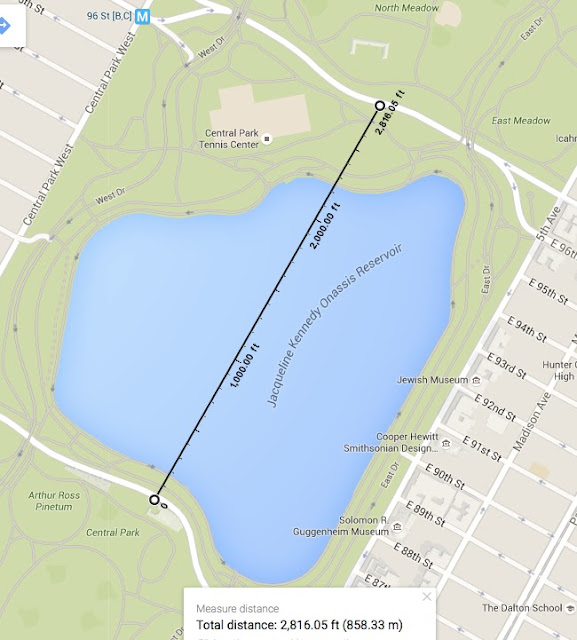Are you trying to get hit by lightning?
Since the Powerball and MegaMillions jackpots are getting into "quit your life" territory again ($977 million for MegaMillions and $750 million for Powerball), you might hear a story about it on your local news. Some try to give meaning to the odds of winning (around 1 in 300 million for each) by saying like "You have a better chance of getting hit by lightning, twice.". I never liked that analogy because most people try not to get hit by lightning. I like better the equivalent of blindly hitting the one marked cup out of 302 million.


Will a football field hold 302 million cups?
Well, if they are small enough, about one-eight-inch across. So, let's use those typical small plastic cups which are about 2 inches in diameter. How many fit into one square foot? (I find many students answer 6, not the correct 36. We then discuss the difference between linear measurements and area ones. To test that concept, I then ask how many square feet in one square yard.) A high school football field is 120 yards by 53.3 yards. Putting it all together, we get that the field will hold 2,073,600 such cups. Which means you need about 146 fields to hold the 302 million MegaMillions cups or about 8.4 million square feet.
Where can I fit 146 football fields?
With available online conversion sites such as Google or onlineconversion.com, you could figure out how many acres (193) or square miles (0.30) would be needed, but those would be meaningless numbers. What about a visual representation? Would a nearby large park be big enough? How can you figure out if it has at least 8 million square feet? Let's use Google Maps and the most famous park in the US, Central Park in NYC, in particular the area around the reservoir.
One nice feature that you might not know about Google Maps is that is has a ruler tool. In the map below, notice the small ruler icon just to the left of the scale legend in the lower left corner. By clicking on that, you can get the distance between any two points.
So we see that that area of Central Park in NYC bounded by the roads around the iconic reservoir is about 8 million square feet (2800 ft by 2800 ft). You can do the same with any park that your students may be familiar with. Now imagine that area covered with cups and you are blindfolded and hovering overhead in a helicopter. You drop a pebble. Your odds of winning the MegaMillions lottery with one ticket is the same as the odds of you hitting the one marked cup in this area of Central Park.
For people in Buffalo, NY, we can do the same for its famous park, Delaware Park.
You can see that you would have to fill in the entirety of the Park north of the 198 (including the Zoo) with these cups. So imagine standing by the Statue of David at the top of the hill and trying to hit the one marked cup without knowing where it is. Your odds of hitting the MegaMillions with one ticket is the same.
Using the approximations that a football field holds about 2 million 2 inch diameter cups, you can do the same for any other lottery game with a little arithmetic. For example, the regular NY Lotto would need 11 football fields or 626 thousand square feet.
For friends and family in my hometown of Claremont, NH, here is a map for you. Fill not only all of Monadnock Park, and the field adjacent to the park and bounded by the Sugar River, but also the residential part between the park and Pleasant St. to fit the 304 million cups for the MegaMillions lottery.
For family members on the Sandy Island Family Camp during the summer, you would need to cover the entire island thrice to get the right number of cups.
One nice feature that you might not know about Google Maps is that is has a ruler tool. In the map below, notice the small ruler icon just to the left of the scale legend in the lower left corner. By clicking on that, you can get the distance between any two points.
For people in Buffalo, NY, we can do the same for its famous park, Delaware Park.
You can see that you would have to fill in the entirety of the Park north of the 198 (including the Zoo) with these cups. So imagine standing by the Statue of David at the top of the hill and trying to hit the one marked cup without knowing where it is. Your odds of hitting the MegaMillions with one ticket is the same.
Using the approximations that a football field holds about 2 million 2 inch diameter cups, you can do the same for any other lottery game with a little arithmetic. For example, the regular NY Lotto would need 11 football fields or 626 thousand square feet.
For friends and family in my hometown of Claremont, NH, here is a map for you. Fill not only all of Monadnock Park, and the field adjacent to the park and bounded by the Sugar River, but also the residential part between the park and Pleasant St. to fit the 304 million cups for the MegaMillions lottery.
For family members on the Sandy Island Family Camp during the summer, you would need to cover the entire island thrice to get the right number of cups.
Another aspect of these lotteries can be seen at another blog post of mine.






No comments:
Post a Comment